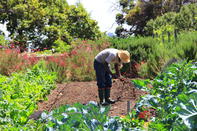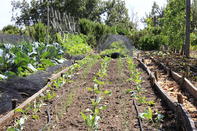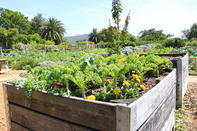There are three popular methods for growing vegetables organically on a small scale. All methods improve soil fertility and are also helpful when money, water and soil is limited.

Vegetables cultivated in this manner will be healthier than conventionally produced vegetables. The three types of vegetable gardens: Trench Bed - Make a hole in the ground and fill it with organic material and soil.
It is possible to plant immediately in a bed prepared in this way. Stacked Beds - In areas where it is impossible to make holes in the soil, stack beds are used. This method is suitable for physically disabled individuals or older people who struggle to bend down.
Container vegetable gardens - Planting vegetables in containers such as pots or tyres.
How to Make a Trench Bed Vegetable Garden
The trench should be 1 m wide, 2 m long and knee deep, about 50 cm. When digging the trench, separate the top and bottom soil - the topsoil is more fertile and darker in colour than the bottom soil. Always dig the trench from east to west. This ensures that plants receive adequate sunlight throughout the day. If dug from north to south, the bed will get too much shade.
Make sure the beds are level, with a slight gradient to allow water to flow downwards, but not too steep to cause erosion. If the soil is at a steep incline (gradient) the beds can be made to obtain a step effect.
The steeper the incline, the more “steps” can be created. Fill the trench half full with organic material - e.g. garden refuse, vegetable peels, egg shells, egg cartons, even weeds.
Also use animal manure from sheep, cattle, goats, chickens, rabbits or pigs. Do not use cat or dog manure, raw meat or fat. Place rough material such as small branches, maize corns, straw or dry grass at the bottom.
This ensures good air flow through the system. Place about six small, squashed and rusted tins on top of the rough material. This is to supply the micronutrients (nutrients needed in very, very small amounts) such as zinc (Zn) and iron (Fe) to the soil. Cover the tins with a layer of torn newspaper or carton. Add the rest of the organic material.
Compact the material and add more organic material if the trench is not yet full. Sprinkle some dry animal manure over. This provides the necessary bacteria needed to start the decomposition process of the organic material to become compost. Wet the material properly, using a garden hose or bucket.
The dampness will assist in the decomposition process. Cover the organic material with the soil from the trench. This will prevent bad smells and flies during the composting process. Fill the trench with the soil taken out - bottom soil first and then topsoil.
Do not stand on the bed. The filled trench should be about 15 cm higher than the soil surface but as the organic material decomposes and nutrients are used by the vegetables, the height of the trench will decrease. The trench bed method is a cheap and effective method, producers do not need to buy nutrients or fertilizer.
Because the crop is healthier it will suffer less from pests and diseases and the cost for pest control can be minimal. This method yields more and a higher quality crop for the following reasons: Organic material used at the bottom of the trench acts like a sponge which takes up water and releases it as needed by the plants.
Organic material turns into compost and attracts beneficial soil microbes. It saves money using less fertiliser and chemicals for pest control. Income can be generated by selling good quality vegetables, or producing vegetables for home consumption, cutting cost by not having to buy food. Organic ‘waste’ is used to fertilize the soil and the environment is kept cleaner.
Stacked Bed Vegetable Gardens

Use this method when you can’t dig holes. Stacked bed vegetable gardens are ideal for physically disabled individuals or those in wheelchairs who still want to cultivate vegetables.
It differs from the trench method in that organic material is layered on top of the topsoil to create a higher bed that the surrounding soil, following the same method as the Trench method, but starting at point 2.
This method has the same advantages as the trench bed method; saving water and adding organic material to the soil, yielding higher amounts of vegetables per unit area.
Vegetable Gardens in Containers

In this method, containers are filled with organic material and a layer of soil is put on top of the organic material. (Remember to wet the organic material properly before adding soil on top). The most common containers are car or truck tyres and are mostly used for the cultivation of potatoes and carrots.
The method can be adapted for the type of crop by stacking up to 5 or 6 tyres on top of each other. About 5 to 6 kg of new potatoes can be harvested from one set of tyres.
Big black rubbish bags and drums can also be used for planting potatoes. Container boxes made from old pallets or pallet boxes are also used, but large plastic containers are found to warp over time.
Line the boxes with shade cloths to allow drainage and keep containers in a sunny position away from cold and drying winds. For top-heavy plants like peppers, tomatoes and eggplants, make sure that the container is large and heavy enough to withstand the weight of the crop.
Add a light mulch such as grass clippings or straw on top of the soil. Newly germinated seedlings can still push through the mulch while the mulch helps to retain moisture and reduce weed growth. Most vegetables - such as pumpkin, peas, beans, spinach, tomatoes and onions - can easily be grown directly from seeds.
When planting seeds, do not plant it too deep - plant each seed no deeper than as three times its width. When planting seedlings, try not to disturb the roots.
Water well after planting and at least three times per week after that, depending on the rainfall. Some plants help each other grow better and protect against predators.
By Louise Brodie